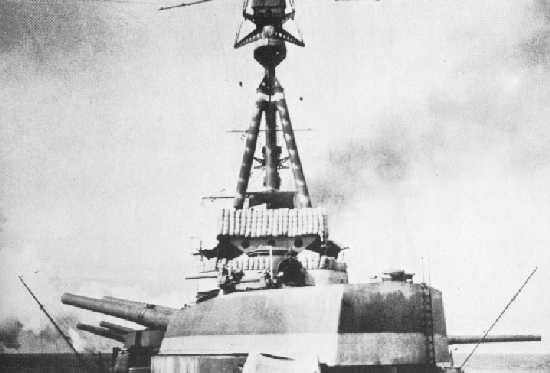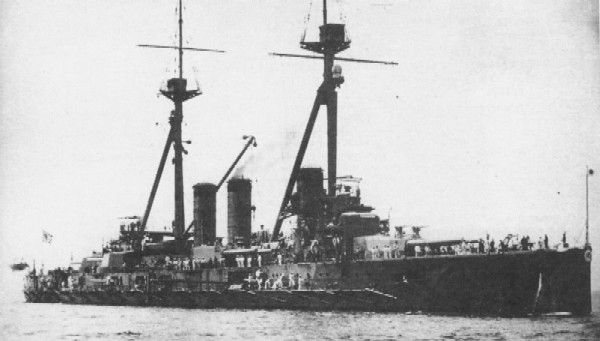| Japan’s First Dreadnoughts, Part III
By Arrigo Velicogna
December 2019
Ship Histories
 While the two new battleships were authorized in 1908, their actual construction started in 1909. Kawachi was laid down on 1 April 1909 at the Yokosuka Navy Yard, while Settsu was laid down at Kure on 18 January 1909. The construction time of previous ships had taken an extremely long time. Delays in securing materials from abroad, design changes, and industrial inefficiencies had conspired to slow down ship building to a crawl. Aki, for example, took five years from keel-laying to commissioning. While the two new battleships were authorized in 1908, their actual construction started in 1909. Kawachi was laid down on 1 April 1909 at the Yokosuka Navy Yard, while Settsu was laid down at Kure on 18 January 1909. The construction time of previous ships had taken an extremely long time. Delays in securing materials from abroad, design changes, and industrial inefficiencies had conspired to slow down ship building to a crawl. Aki, for example, took five years from keel-laying to commissioning.
Yet while Aki and Satsuma were built largely with imported material, Kawachi and Settsu used more indigenous components. Their Curtis turbines were produced under license in Japan rather than in the United States. Of the main components only the 12-inch guns were supplied directly by Vickers. This led to a shorter construction time. Kawachi was commissioned in March 1912, and Settsu in July of the same year. A little less than three years were required to build both ships, a striking contrast on the more than five necessary for Aki.

Kawachi's 12-inch guns.
When they entered service in 1912 they represented a massive quantum leap in naval technology for the Imperial Japanese Navy. They were heavily armed, well protected, and compared to the ships designed at the same time, quite fast. Both ships were capable of 20 knots, making them only one knot slower than the vaunted Dreadnought. They were more heavily armed with two more 12-inch guns than the British ship and a considerable secondary battery, a battery that, as previously discussed, was at the time more effective than the primary.
Yet for all their positive traits Kawachi and Settsu had the misfortune to enter into service in a period when naval technology was developing fast. In the timeframe between the completion of the Dreadnought and that of the two Japanese ships, the Royal Navy had introduced the first mechanical computer for producing fire solutions. It had also changed optical component in its rangefinders allowing them to actually see target at long range. Of course these machines were rudimentary and, even in 1915, incapable of producing reliable results, but they moved long-range fire closer to the realm of the practicable. Main gun calibers had also increased; the 12-inch guns of 1906 had been replaced by 13.5-inch or even 15-inch guns. Finally turbines had also improved allowing for faster ships. These elements conspired to make the two battleships outdated even when brand-new. Yet among the Pacific powers they were the most powerful ships available, much better than the American South Carolina class in armament, speed, and protection.
They operational career was uneventful at best. In 1914, when Japan declared War on Germany and Austria-Hungary their place of pride in the fleet had already been occupied by the HIJMS Kongo, and a year later the first Japanese super-dreadnought battleship designs, represented by Fuso and Yamashiro, entered service. Yet Settsu and Kawachi continued their duty during the Great War as part of Japan’s fleet-in-being, patrolling home waters and conducting training exercises. On 12 July 1918 Kawachi suffered a catastrophic explosion that destroyed the ship with the loss of more than half of the crew. Investigators at first suspected arson, but were unable to find any suspect or evidence, and then settled for an explosion caused by the decomposition of the cordite stored in her magazines. Yet the ship had been inspected in January and February of the same year and nothing untoward had been found in her magazines. In the early part of the Twentieth Century it was sadly common for battleships to suffer such explosions. Often it was due to improper storage of cordite charges or unstable cordite, the latter a result of faulty production. The Navy investigative committee, while blaming the explosion on decomposition and thus on human error, also recommended increased quality tests in ammunition production facilities.

Kawachi at anchor.
The loss of the Kawachi left Settsu alone in her class. The end of the Great War and the introduction of newer and more powerful ships ended her career. She was the only modern battleship in the navy armed with 12-inch guns while the other major ships had larger guns. The Fuso, Ise and Kongo classes had 14-inch guns while the new Nagato class had 16-inch guns. The new ships then in the design stage or under construction had 16-inch or 18-inch guns.
Settsu was placed in reserve in 1919, serving ceremonial duties, including acting as “yacht” for Empress Teimei in 1922. The Washington Naval Limitations Treaty spelt her end. The Navy struck her from the list in October 1923. The following year she was converted in a target ship, and had her armor increased at the cost of reducing her speed to 16 knots. She served as stationary target until 1935 when she was transformed into a radio-controlled target. In this capacity she served until 1945, when she was sunk by US carrier aircraft after two attacks. During this period she once was used to transport a Special Naval Landing Force from Sasebo to Shanghai in 1937 and, in December 1941, as radio decoy to mask the movement of the 1st Mobile Fleet to Paramushiro and then Pearl Harbour.
Conclusions
Often the HIJMS Kawachi and Settsu are considered the first Japanese dreadnoughts. It is tempting to consider them that way. Their lines were modern for the time and, more importantly, they were both powered by turbines and their main armament was composed of twelve 12-inch guns. Still, as discussed earlier, these data alone are misleading. Two-thirds of their main armament was of a different caliber from the rest. The centerline guns were 50 calibers long while the beam ones were 45 calibers long. This characteristic alone disqualifies them from being single-caliber battleships like HMS Dreadnought. To be extremely picky, as I am, their classification has to be that of semi-dreadnought, rather than dreadnought. Yet this difference could have been as overstated as the entire Dreadnought revolution.
Their service life was short and largely uneventful, if we discount the tragic loss of the Kawachi. Yet they constituted an important step forward in the history of Japanese warship construction. They did not represent a clear break with pervious ships but an evolution of preceding designs updated to incorporate new technologies (steam turbines). The overall layout was not markedly different from the two preceding battleships, Aki and Satsuma. Still they are important warships in the history of the Imperial Japanese Navy and they have also a considerable historical significance.
Usually the commissioning of the HMS Dreadnought has been seen by historians as a clear dividing line and a revolutionary step in warships design. Yet it seems that in the years immediately following her commissioning admirals and naval architects were much less impressed by her than were later historians. Ships’ design did indeed change but in a more evolutionary way than is usually credited.
In the light of these arguments Kawachi and Settsu make much more sense. They incorporated turbines and increased their main armament but still kept, as insurance, the proven and effective 6-inch batteries. That long-range fire with heavy guns, a thing that was more or less a dream in 1908, was becoming a more and more realistic proposition in 1912 could not have possibly been known to the Japanese designers. Even more importantly, long-range heavy guns were still awfully inaccurate even in 1916. Thus ships like our two battleships represented indeed an important step in the history of naval technology, even if later historians have dismissed them as bungled designs.
Click here to order Cruiser Warfare: Final Edition.
Sign up for our newsletter right here. Your info will never be sold or transferred; we'll just use it to update you on new games and new offers.
|
